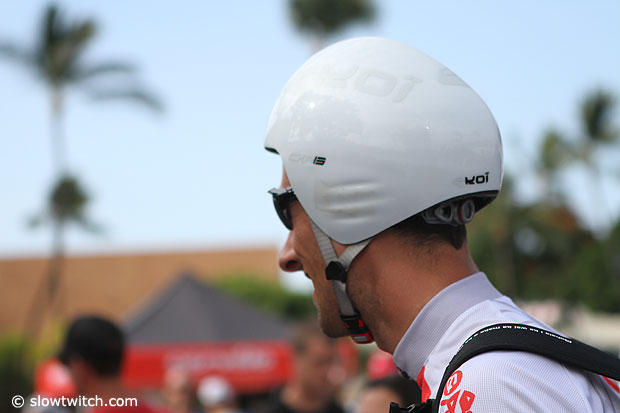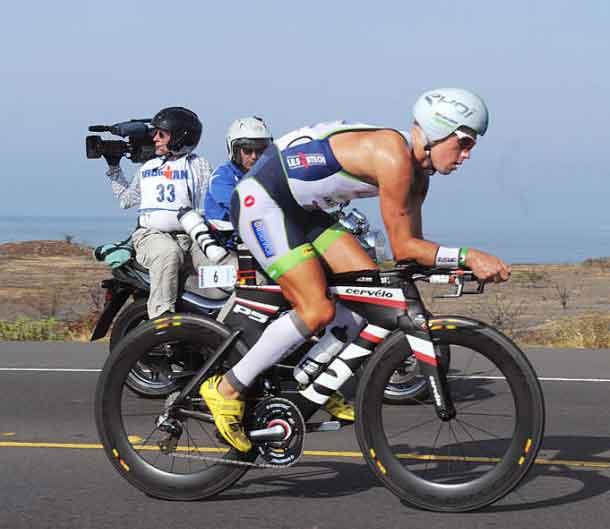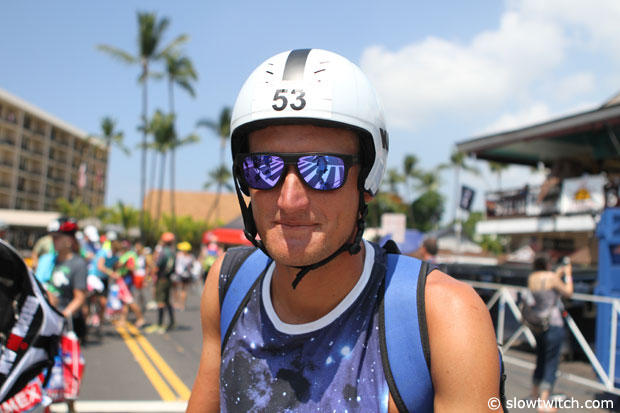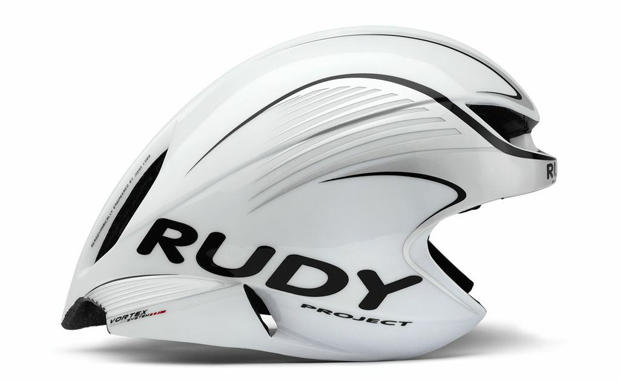Helmet rule upheaval
Spain’s Victor Del Corral won Ironman Florida this past weekend with a superb 7:53:12. In so doing Del Corral had to overcome the fastest bike split ever produced in an Ironman, 4:02:17, by Andrew Starykowicz. Del Corral needed everything to overhaul Starky – who did not fold after his overwhelming ride – in the final miles of the run.
But Del Corral faces a DQ, not because he drafted, or cut the course, but because he used a helmet worn many times by many athletes while racing in the United States. Del Corral raced with an Ekoi CXR13. This is not a CPSC-certified helmet. One of the images you see contained here is the CXR13, snapped by our editor-in-chief Herbert Krabel, during bike check-in the day before this year’s Hawaiian Ironman World Championship. The other image is of this helmet aboard the winner of that race, Frederick Van Lierde, in a pic taken by Timothy Carlson.

Why is this helmet legal in Hawaii but not in Florida? Because USA Triathlon, sanctioner of both races race, grants a dispensation from the strict CPSC-only rule for world championships WTC produces in Las Vegas and Kona, only because there are so many foreign athletes entered in these races and it would cause mayhem for these athlete to be turned away because they don’t have conforming helmets. However nearly half the contestants in the 2,800-person Ironman Florida came from a foreign country, and this race is not exempted from the CPSC requirement. This means not only Del Corral races with a CE helmet, very likely more than 1000 of the event’s contestants did not wear a CPSC helmet (it is not WTC’s policy to check every helmet for a CPSC sticker, nor does USAT require this of WTC).
Could these foreign athletes buy CPSC helmets prior to the race? In Europe or Australia? Europe has its own standard, analogous to the CPSC (Consumer Products Safety Commission), and the designation is CE. Japan and Australia have their own certifications and it is even against traffic laws to ride a bike anywhere in Australia without a helmet that meets the Australian standard. In other words, no, you cannot buy a CPSC helmet in these other countries for the same reason you cannot legally sell a non-CPSC helmet in the United States.
The exception to this is in athletic events, where reciprocity in helmet standards is honored. I have yet to find a single American athlete turned away from, or disqualified from, a race on non-U.S. soil because he or she arrived with a CPSC helmet. The great majority if not all other countries honor the CPSC sticker.
Barbara Riveros, the talented Chilean pro, was turned away from racing at HyVee because her Specialized Evade helmet had a non native sticker inside. "I got the helmet without sticker but a local Specialized dealer fix it for me so I trust them. I used this helmet one race before Hyvee in USA and it was fine," said Riveros to slowtwitch. But no matter what was argued, Riveros was still not allowed to race because it was not the original CPSC sticker.
It’s common for a helmet maker to manufacture two very similar helmets and place in these helmets the sticker specific to the country or continent of sale. In defense of the helmet decision made at HyVee, because the CE standard allows for a lighter helmet, some helmet makers manufacture to the CE standard, to meet the competitive needs of that market – and then make changes to the helmet, including an increase in the density of the foam – to make the helmet CPSC-compliant. Consequently, it might not be as ministerial as looking at Ms. Riveros’ Specialized Evade and knowing that, while the helmet is CPSC-certified in the U.S. it is necessary built to that standard if she got it in Europe.
“The rules are the rules whether we like them or not,” wrote one Slowtwitcher on a thread on this subject of helmets used during Ironman Florida. He’s absolutely right. You can’t preach that the process trumps the outcome if you’re only willing to follow the process when it suits you. But let’s look at the rule. This is from USA Triathlon’s rulebook. 5.9(a):
“Type of Helmet. All participants shall wear a protective head cover, undamaged and unaltered, which meets or exceeds the safety standards of the Consumer Product Safety Commission (CPSC). Helmets manufactured prior to March 10, 1999 must meet or exceed the safety standards of (i) the American National Standard Institute (ANSI Z-90.4), (ii) The Snell Memorial Foundation (Protective Headgear for Bicycle Users), or (iii) ASTM F-1446 or F-1447, and which is clearly labeled by the manufacturer as satisfying such standards. Removal of helmet cover, if required for that helmet to meet such safety standards, shall constitute an impermissible alteration in violation of this Section 5.9(a). Any violation of this Section 5.9(a) shall result in disqualification.”
I’ll strip it out the relevant part of this rule and reproduce it below so that we can focus on it:
All participants shall wear a protective head cover, undamaged and unaltered, which meets or exceeds the safety standards of the Consumer Product Safety Commission (CPSC).
Three things seem to me to be relevant, and to make common sense: First, that the helmet need not be a CPSC-certified helmet, but must be a helmet that is as safe as a CPSC helmet. Second, that no sticker must be in the helmet. Certainly it’s easier for an official checking helmets if a sticker is in the helmet, but, the rules are the rules whether we like them or not. No sticker required, except for those Ansi or Snell helmets manufactured before 1999.
Third, it is not even a requirement that the helmet meet CPSC standards required for certification. It is required that it meet the safety standards the CPSC requires for certification. I can certainly imagine a case where a helmet would meet all safety standards, but has not yet met whatever procedural or financial hurdles required to get the sticker.
Is a CE helmet as safe as a CPSC helmet? That’s not a straightforward question to answer. Clint Mattacola does helmet R&D for Specialized Bicycles and works specifically in “World Wide Compliance and Documentation.” Does a CE helmet, in all relevant ways, meet or exceet the CPSC safety standard? “The short answer is no,” says Mattacola, “A CE certified helmet does not meet the CPSC standard.”
But it’s not quite that simple. What Mattacola goes on to say is that it might meet the CPSC standard but you don’t know unless you test it, and unless it bears the sticker you don’t know if it’s been tested to that standard. “Is the CE certification one that a helmet can pass while still falling short of meeting the safety standards of the CPSC?” asks Mattacola. “You don’t know until you test the helmet to the CPSC standard.”
What is the difference between the CE & CPSC standards? “Several things differ but the most prominent is the hemispherical anvil impact and the number of impacts per helmet,” answers Mattacola. “CPSC requires that you impact the helmet against 3 anvils: flat, curb and hemispherical. CE requires only flat and curb, no hemispherical impact is required for CE certification.” Also, “The number of impacts required to certify a helmet to the CE standard is 2 impacts per helmet, one flat and one curb. The CPSC standard requires 4 impacts per helmet 2 flat and 2 hemispherical on 50% of the samples and one curb impact on 50% of the samples.”
Does this mean that a CPSC helmet is safer than a CE helmet? Not necessarily. It is probably more safe in very high impact crashes, because of the higher density foam required to pass the anvil tests described above. Some make the argument that a CE helmet is more safe in a lower-velocity crash that might be more typical of the majority of bike crashes. But it’s impossible to know because we don’t use human subjects as bicycle helmet crash test dummies.
But this discussion misses what seems to be some crucial points. USA Triathlon allows helmets the predate the CPSC’s involvement in helmet certification. As you see from the rule above, a helmet made pre-1999 must bear a Snell or Ansi sticker (this is the only sticker requirement in the rule). But this rule has not changed in a long time and one must ponder the wisdom of allowing a helmet that’s 14 years old or older. A CE helmet made today is certainly much safer than a CPSC-stickered helmet made a decade ago or an ANSI-stickered helmet made two decades ago. A CE helmet purchased this year is arguably safer, in any kind of crash, than the mean safety performance of all the CPSC, ANSI and Snell helmets in the transition area of any race today.
In other words, are we looking at the wrong metrics? Should we be looking at not only the safety of the helmet when it was built, but the age of the helmet? Today’s helmets, whether Australian (AS/NZS 2063), CPSC and CE, are pretty safe. What about helmets made a long time ago? Should we allow them in the race? Certainly you don’t want to disenfranchise people by disallowing their helmets, but right now there are thousands of athletes who’ve purchased wetsuits and swimskins costing from $200 to $700, only 3 or 4 years ago, who are disenfranchised.

Who has the toughest safety standards on the planet? Australia. It’s standard is called AS/NZS 2063 and it’s universally accepted as the world’s most stringent. Australia was the first country to make helmets compulsory while riding on the road, and it’s not just illegal to sell helmets that are not AS/NZS 2063-certified helmet, you must also ride a helmet bearing that certification.
Except in competition. Here’s the rule in Australia, in triathlon, per Triathlon Australia’s rulebook, (3.3): “Bicycle helmets are compulsory and must be approved by a testing authority which is recognised by a national federation that is an affiliate of the International Triathlon Union (ITU).”
And, while CPSC or Department of Transportation motorcycle helmets are not allowed for motorcycle riding in Germany (U.S. servicemen are compelled to buy CE motorcycle helmets when billeted in that country), only the U.S. fails to honor helmet standard reciprocity while racing in another country.
Even Edward Becker, executive director of the Snell Foundation, an ardent supporter of tough helmet standards and a champion of the CPSC’s rigorous requirements told me, when asked what the most practical solution was to this problem of athletes traveling to race on foreign soil, that he favored requiring each athlete have a helmet that (at a minimum) conformed to his or her country’s helmet standard.
For years this issue has been languishing at the mid-level of governance in the U.S. Ben Fertic would routinely privately rail against the CPSC requirement, and he’s been out as CEO of WTC for 2-and-a-half years. Finally the big ship is turning as USA Triathlon seeks both to harmonize with the rules of competition used worldwide (a stated goal of USAT’s for some years now), as well as to keep onerous rules from ruining the race experience of those who in every other way respect and abide by standards of fair and safe racing. A panel convened to review rules of competition is looking at all rules and practices at variance with those used in other countries and the helmet rule is among them.
That’s good. However, as stated, officials ruling on helmet issues like that of Ms. Riveros and affecting Mr. Del Corral today are not required to demand either a CPSC sticker or even that the helmet is CPSC-certified. It’s not required in USAT’s rules, and it’s not creating havoc with USAT’s insurer. I have yet to find (I’ve tried, I’ve asked) anyone associated with USAT’s insurance to show me any evidence that an underwriter at a carrier is even familiar with the issue, let alone fixed on specific text in the helmet rule.
Bear in mind the implications of the helmet rule as it has been interpreted. Close to half the roughly 2,800 participants at Ironman Florida came from foreign countries, chiefly from the Eastern or Southern Hemispheres. Most of these countries live under correspondingly similar laws as those governing helmet sales in the U.S., specifically, that they have their own helmet safety standards and helmets sold in those countries must meet them.
Therefore, technically, under today’s understanding of USAT’s helmet rule, a CPSC helmet must be worn by every competitor. Some number between 1000 and 1,400 athletes alighting on U.S. Soil to compete in Ironman Florida is required to wear a helmet unobtainable in the country in which they live. They must fly to Panama City and queue up for the more-than-1000 helmets sold – where? Walmart? – in order to meet the rule’s requirement. This, while on the same weekend Americans flew to race in Noosa, Australia – a country with a stricter helmet standard than the CPSC’s – where reciprocity is the rule.





